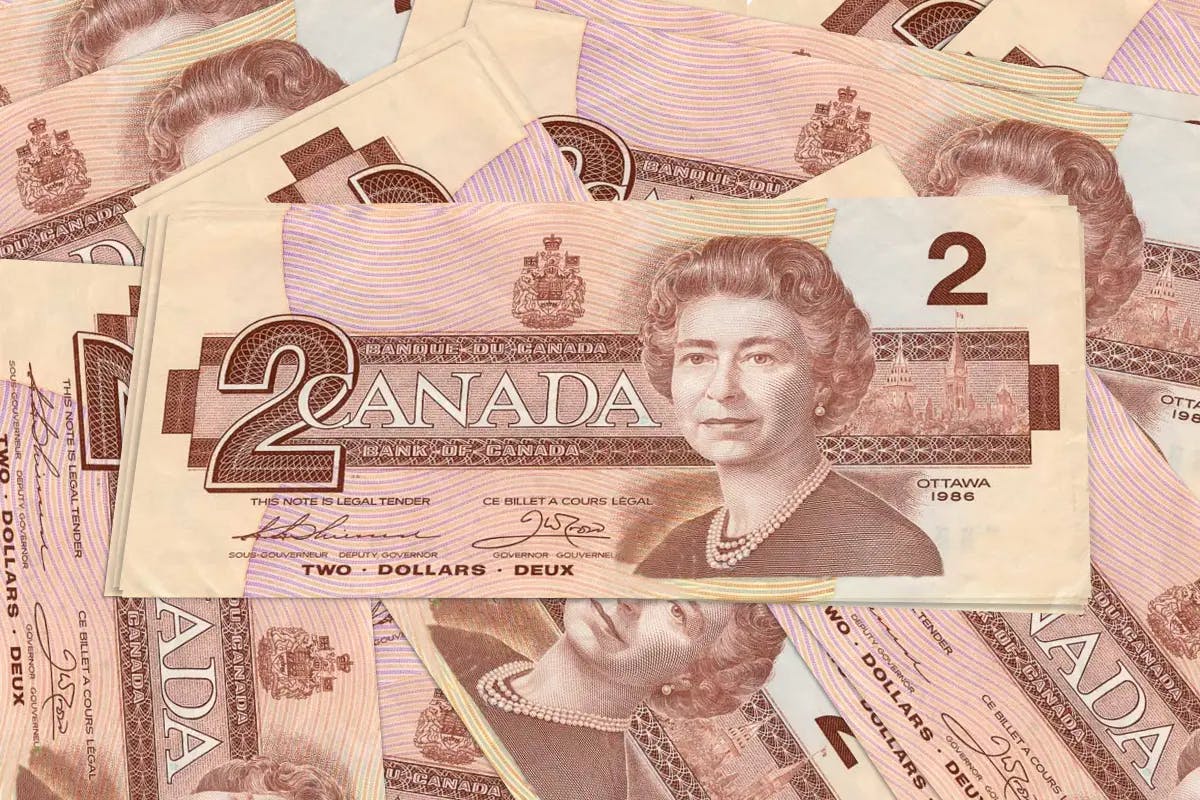5 Things You Might Not Know About the Canadian 2 Dollar Bill
By JC Pittman | Published on 15 Aug 2022

Throughout history, the lands now known as Canada have had a myriad of different forms and types of currencies, in a variety of denominations. The majority of these denominations fell to the wayside over time. The most recent of which was the Canadian 2 dollar bill. In this article, we’re going to dig into the Bank of Canada’s history and explore five things you may not know about the Canadian 2 dollar bill.
The 2 dollar bill was issued by the Bank of Canada from 1935-1996. During its time in circulation, the bill featured three different members of the British Royal family on the obverse (the “heads” side of currency), and a changing thematic engraving on the note’s reverse (the “tails” side of currency). Queen Elizabeth II graced the obverse of every Canadian 2 dollar bill printed from 1954’s “Landscape Series” to the note’s withdrawal in 1996.
#1: The Canadian 2 Dollar Bill Speaks Another Language
A portrait of Queen Mary, wife of King George V, was the first member of the Royal family to grace the Canadian 2 dollar bill in the “First Series” in 1935. The changes to the bill from the “First Series” to the “Bilingual Series” were significant and had lasting impacts on the stylistic direction of Canadian bank notes in the future.
The portrait of Queen Mary was replaced by King George VI and moved to the centre of the notes in the “Bilingual Series.” This portrait orientation was standard across the “Bilingual Series.” The colour scheme introduced with the “Bilingual Series” became the standard (with a few tweaks) for the Bank of Canada’s bank notes to the present. In 1937, the Canadian 2 dollar bill was introduced with its terracotta shade, known as “sanguine.”
Finally, the engraving on the reverse of the bill changed from the “First Series” to the “Bilingual Series.” The “First Series” featured an allegorical engraving representing transportation on the note’s reverse. The “Bilingual Series” opted to take inspiration from the “First Series” for the 1937 Canadian 2 dollar bill, using the allegorical engraving of harvest from the “First Series” $10 note.
#2: The North’s North Gets Some Shine.
As a Canadian Environmental historian, I marvel at the Canadian North. I often think that Northern Canada doesn’t receive as much focus and exploration from the rest of the country as it should. In fact, I wrote two theses’ on a Northern Canadian river valley. For real.
Much like Myself in academic research, The Bank of Canada looked North for inspiration for the engraving on the back of the “Scenes of Canada” series of the bill. They also looked to another Canadian Institution: the National Film Board.
In particular, they searched through the collection of still photos and films from Doug Wilkinson’s Land of the Long Day. The Bank of Canada chose a colour image of hunter Joseph Idlout as the subject for engraving and enshrinement on the back of the bill.
Idlout was the leader of a small community of families in a summer hunting camp on Baffin Island, known as Aulatsiivik. Wilkinson’s goal was to capture the Aulatsiivik’s combined use of traditional and modern technology in their daily life and for their survival. You learn more about Idlout, Land of the Long Day, and the Canadian 2 dollar bill engraving here.
#3: Funny Money in the West
If you are from a generation when physical cash was significantly more prevalent in society, you’ll likely have heard Canada’s currency (and most of the world) being mocked by Americans for its now signature multi-coloured design scheme. The Canadian 2 dollar bill was subject to regional mocking, as different geographical regions preferred using different denominations of cash.
“In the West, $2 bills are funny money.”
Alan Edmonds in MacLean’s, October 1st 1967
In 1967, Canadian’s relationship with the 2 dollar bill was a complicated one. The bill was used at a 1:1 ratio as the Canadian 1 dollar bill in British Columbia. People in Vancouver used more 2 dollar bills than any other part of the country. East of Manitoba, banks reported using one 2 dollar bill for every two 1 dollar bills.
In Regina, the ratio was 400-1 in favour of the Canadian 1 dollar bill. The Interprovincial Steel and Pipe Corporation (ISPC) used this regional disdain for the 2 dollar bill to prove how valuable they were to the local economy. The ISPC paid its employees in 2 dollar bills so that the sudden increase in the notes’ regional circulation could be connected to their importance as an employer.
Why the Prairie paranoia toward the Canadian 2 dollar bill?
Bankers pointed in four directions, all of which included bad luck or misfortune of some sort. The Canadian 2 dollar bill was commonly associated with: gambling on horse racing, a reported connection between the word “deuce” and the Devil, imported superstitions from America’s struggles with almost identical currency designs of the American 2 and 5 dollar bills, and a connection between the Duke of Windsor’s image on the Canadian 2 dollar bill and his real-life accident history.
#4: Red-Light Connections
The terracotta-coloured Canadian 2 dollar bill might not be a vivid red like the Canadian 50 dollar bill, but it has a long history with the colour red. As in red-light districts and prostitutes in the Western provinces. Yet another reason for puritanically-inclined Westerners to dislike the 2 dollar bill.
Restaurant staff from Winnipeg in the 1970s and 80s recall the regional connection between Winnipeg’s long-established and tolerated red-light district and the Canadian 2 dollar bill. They noted that people didn’t want to be associated with the bill because back then, “I guess you got a screw for a two.”
Others noted that in Edson, Alberta no one used the Canadian 2 dollar bill because of their reported connection to “how much a lady of the evening cost.” The same person noted that it was even considered an insult to give a 2 dollar note as the change in a transaction.
#5: The End of an Era & the Rise of the “Toonie”
If you have ever seen a Canadian 2 dollar bill, you have likely seen a bill from the “Birds of Canada” Bank note Series. Each bird was selected for enshrinement on the 1986 series due to their pan-Canadian habitat and to compliment the long-established Canadian bank note colour scheme. For the Canadian 2 dollar bill, the robin served as the inspiration for the terracotta-coloured bill’s reverse side.
Like the majority of Canadian 2 dollar bills, the “Birds of Canada” series featured a portrait of the Head of the Monarchy; in this case, a portrait of Queen Elizabeth II was featured on the obverse of the bill. Colour copiers prompted enhanced security features across the “Birds of Canada” series, including four specific places of raised ink and random green dots on both sides of the notes.
In the 1995 federal budget speech, the Canadian government announced that the bill was being pulled from circulation, and replaced by the more durable and economically beneficial two-dollar coin, the toonie. The terracotta-coloured bill was officially withdrawn on February 16, 1996.
If you have a Robin-adorned Canadian 2 dollar bill, you may want to check the serial number and hope the note is in prime condition. Canadian 2 dollar bills with the AUH-prefix were printed in 1986 and could be worth between $3000 – $15,000. A generation of Canadians exchanged freshly lost teeth for this 2 dollar bill that could net you up to $20,000 if you have a mint-condition note. In the mean time, check out the best chequing account to put you hard earned dollar bills in!
